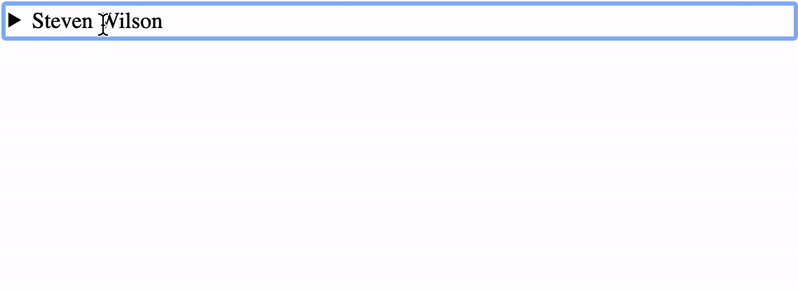This content originally appeared on DEV Community and was authored by Ayush Newatia
<details> and <summary> tags are among of the most useful tags that HTML gives us. I'm constantly surprised by how esoteric they are in practice.
In its simplest use case, the <details> tag gives us an "open/close" toggle control that shows the contents of the <summary> tag when closed; and all its contents when openend by clicking on it.
<details>
<summary>Steven Wilson</summary>
Steven John Wilson is an English musician, singer, songwriter and record producer. Currently a solo artist, he was the founder, guitarist, lead vocalist and songwriter of the band Porcupine Tree, as well as being a member of several other bands, including Blackfield, Storm Corrosion and No-Man.
</details>
When the details are open, the <details> tag has an open attribute so we can target some CSS styles on the open attribute to visually change the control's state:
details[open] {
background: gray;
}
Here's a codepen for the above example.
There are a plethora of applications for <details> / <summary> tags such as accordions or dropdowns. You can build these components with these tags without any JavaScript at all!
Let's take a look at how easy it is to build a dropdown using <details> / <summary>.
Dropdown menu using details / summary tags
The HTML markup for our dropdown is incredibly straightforward. The CSS is where the interesting stuff happens.
This is what the HTML for a simple menu with 3 items would look like:
<details>
<summary>
Menu
</summary>
<ul>
<li>Settings</li>
<li>Profile<li>
<li>Logout</li>
</ul>
</details>
To make this into a proper "dropdown" menu we need to alter its behaviour using CSS:
/* Hide arrow glyph */
details > summary {
list-style: none;
cursor: pointer;
}
/* Hide arrow glyph in Safari */
details > summary::-webkit-details-marker {
display: none;
}
/* Set position to relative so we can position */
/* the list of menu items with `absolute` in relation */
/* the `details` tag */
details {
position: relative;
}
/* Add some styles to make the dropdown menu stand out from */
/* the rest of the page. A high `z-index` ensures it stays */
/* on top of all the other content. */
details ul {
display: block;
list-style: none;
padding: 0;
border: 2px solid black;
width: 100px;
z-index: 100;
position: absolute;
background: black;
color: white;
}
Here's what the end result looks like:
We have a dropdown with just a few lines of CSS and no JavaScript at all! Here's a CodePen you can play around with.
The next time you need to build a control with an "open" and "closed" state, reach for <details> / <summary> instead of rolling some custom JavaScript!
This article was originally published on my blog
This content originally appeared on DEV Community and was authored by Ayush Newatia
Ayush Newatia | Sciencx (2021-06-08T19:16:40+00:00) Details & Summary tags: HTML’s best kept secret. Retrieved from https://www.scien.cx/2021/06/08/details-summary-tags-htmls-best-kept-secret/
Please log in to upload a file.
There are no updates yet.
Click the Upload button above to add an update.


